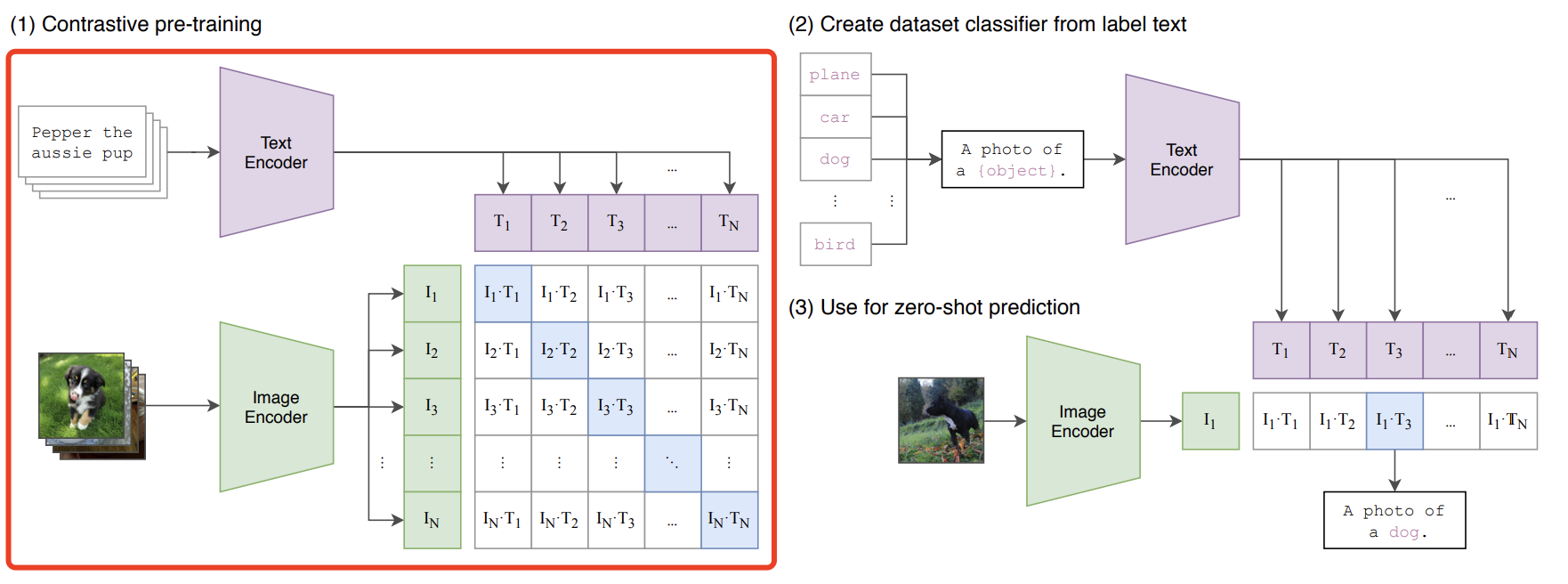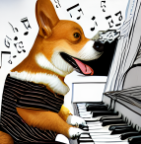记录 CLIP 论文阅读、zero-shot实验(直接推理)、linear probe实验(冻结CLIP抽特征只训练分类层)。
一、论文阅读
Paper:Learning Transferable Visual Models From Natural Language Supervision
Github:https://github.com/openai/CLIP
参考视频:CLIP 论文逐段精读【论文精读】
CLIP(Contrastive Language-Image Pre-training) 是 2021 年 OpenAI 的一篇工作,目的是用文本作为监督信号训练可迁移的视觉模型,模型原理如下红框所示:

- Text Encoder:用的是 Transformer,12层,8个head,512维特征,分词器用 BPE 字节对编码;
- Image Encoder:实验时选了5个不同的 ResNet、EfficientNet 和 3 个不同的 ViT,最终选用 ViT-L/14@336px。
具体模型超参如下:

-
训练阶段:预训练目标通过对比学习,让模型学习文本-图像对的匹配关系,也就是上面模型原理图中,蓝色对角线为匹配的图文对。训练集用的他们自己采集的包含4亿个图文对的 WIT(WebImageText)数据集。
-
推理阶段:用 prompt engineering(比如图像狗猫二分类,分别输入 “ A photo of cat ” 和 “ A photo of dog ”,然后分别跟图像特征算相似度) 和 prompt ensemble(设计了80多个prompt,比如可以对 “cat”、“dog” 用不同的prompt构造输入文本,分别抽特征然后打分)。
以下是模型工作流程的伪代码:
# image_encoder - 残差网络 ResNet 或者 Vision Transformer
# text_encoder - CBOW 或者文本 Transformer
# I[n, h, w, c] - 训练图像,n是batch size,h/w/c分别是高/宽/通道数
# T[n, l] - 训练文本,n是batch size,l是文本长度
# W_i[d_i, d_e] - 可学习的 图像嵌入 投影矩阵
# W_t[d_t, d_e] - 可学习的 文本嵌入 投影矩阵
# t - softmax 可学习的 temperature 参数
# 抽特征 I_f 和 T_f
I_f = image_encoder(I) #[n, d_i]
T_f = text_encoder(T) #[n, d_t]
# 对 I_f、T_f 分别点乘各自投影矩阵,投到同一个向量空间,并做 norm 得到各自特征向量。[n, d_e]
I_e = l2_normalize(np.dot(I_f, W_i), axis=1)
T_e = l2_normalize(np.dot(T_f, W_t), axis=1)
# 算图文特征的余弦相似度。[n, n]
logits = np.dot(I_e, T_e.T) * np.exp(t)
# 对称损失函数(对比学习常用)
labels = np.arange(n)
loss_i = cross_entropy_loss(logits, labels, axis=0)
loss_t = cross_entropy_loss(logits, labels, axis=1)
loss = (loss_i + loss_t)/2
二、zero-shot 推理实验
本部分直接加载预训练好的模型权重进行 zero-shot 推理。
-
新建项目 openai_clip,参考 Github,源码安装 clip 等依赖:
pip install git+https://github.com/openai/CLIP.git -
将模型权重手动下载到本地(ViT-B/32):
wget https://openaipublic.azureedge.net/clip/models/40d365715913c9da98579312b702a82c18be219cc2a73407c4526f58eba950af/ViT-B-32.pt -
存入测试图片
piano_dog.png,新建zero-shot.ipynb,运行代码:import torch import clip import os import numpy as np from PIL import Image os.environ['CUDA_VISIBLE_DEVICES']='1' device = "cuda" if torch.cuda.is_available() else "cpu" clip.available_models()测试图片:

可用模型权重列表:

-
加载模型,查看模型信息:
model, preprocess = clip.load("ckpt/ViT-B-32.pt", device=device) input_resolution = model.visual.input_resolution context_length = model.context_length vocab_size = model.vocab_size print("Model parameters:", f"{ np.sum([int(np.prod(p.shape)) for p in model.parameters()]):,}") print("Input resolution:", input_resolution) print("Context length:", context_length) print("Vocab size:", vocab_size)
-
提取图文特征,计算相似度:
image = preprocess(Image.open("./dataset/piano_dog.png")).unsqueeze(0).to(device) text = clip.tokenize(["a dog eating an egg", "a dog singing a song", "a dog playing a piano"]).to(device) with torch.no_grad(): image_features = model.encode_image(image) text_features = model.encode_text(text) print("图文特征:", image_features.shape, text_features.shape) logits_per_image, logits_per_text = model(image, text) probs = logits_per_image.softmax(dim=-1).cpu().numpy() print("图文logits:", image_features.shape, text_features.shape, probs.shape) print("Label probs:", np.around(probs, 3)) # prints: [[0.9927937 0.00421068 0.00299572]]可见,“a dog playing a piano” 的概率最大。

三、Linear Probe 训练实验
论文里提到,冻住 CLIP用来抽特征,然后加个线性层用于分类,用 8-shot 及以上的样本训一波之后,效果会比直接 zeroshot 好。所以用 sklearn 实战一下。

import os
import clip
import torch
import numpy as np
from sklearn.linear_model import LogisticRegression
from torch.utils.data import DataLoader
from torchvision.datasets import CIFAR100
from tqdm import tqdm
# 加载模型
device = "cuda:4" if torch.cuda.is_available() else "cpu"
model, preprocess = clip.load('./ckpt/ViT-B-32.pt', device)
# 加载 cifar100 数据集 (root 路径下需包含解压后的 cifar-100-python 文件夹)
root = os.path.expanduser("./dataset/cifar100/")
train = CIFAR100(root, download=True, train=True, transform=preprocess)
test = CIFAR100(root, download=True, train=False, transform=preprocess)
# 模型只用于提取特征
def get_features(dataset):
all_features = []
all_labels = []
with torch.no_grad():
for images, labels in tqdm(DataLoader(dataset, batch_size=100)):
features = model.encode_image(images.to(device))
all_features.append(features)
all_labels.append(labels)
return torch.cat(all_features).cpu().numpy(), torch.cat(all_labels).cpu().numpy()
# 构造 sklearn 的 train_X, train_y, test_X, test_y
train_features, train_labels = get_features(train)
test_features, test_labels = get_features(test)
# 初始化一个 logistic regression 对象
classifier = LogisticRegression(random_state=0, C=0.316, max_iter=1000, verbose=1)
classifier.fit(train_features, train_labels)
# 评测一下
predictions = classifier.predict(test_features)
accuracy = np.mean((test_labels == predictions).astype(np.float)) * 100.
print(f"Accuracy = {
accuracy:.3f}")